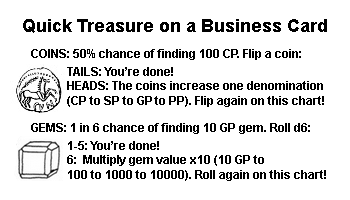I don’t like to slow down the game by flipping through rulebooks – that’s why I made the Monster Manual on a Business Card and various other rules minifications. Here’s a treasure-generation rule that I made up recently when I didn’t have a DMG with me.
Flip for Coins
You shouldn’t roll dice to determine how many coins you find: you should flip coins. When the DM announces that you’ve found treasure, everyone digs into their pocket for loose change. Each player generates a little piece of the treasure haul.
Each player flips a coin. On a heads, you find 100 copper pieces. Keep flipping. Every time you get a heads, the coins increase by one denomination (copper to silver to gold to platinum). The first time you flip tails, you’re done: you walk away with your treasure.
 The average amount of money generated with this system is something around 40 GP per player, with a 6% chance of getting the maximum value of 100 platinum. With five players, your expected money value comes within a few GP of the average treasure generated by using the treasure chart from the DMG random dungeon generator (and Dungeon Robber). If you want, you can scale the treasure the same way Gary Gygax does: multiply the number of coins by the dungeon level. Thus, on level 3, each treasure is made up of 300, instead 100, coins.
The average amount of money generated with this system is something around 40 GP per player, with a 6% chance of getting the maximum value of 100 platinum. With five players, your expected money value comes within a few GP of the average treasure generated by using the treasure chart from the DMG random dungeon generator (and Dungeon Robber). If you want, you can scale the treasure the same way Gary Gygax does: multiply the number of coins by the dungeon level. Thus, on level 3, each treasure is made up of 300, instead 100, coins.
To make the experience as close as possible to the greedy act of pawing through coins, use a penny for the first (copper) coin flip, a nickel for the silver flip, a dime for the gold flip, and a quarter for the platinum flip.
Or even better, back the Best Damn Metal Gaming Coins kickstarter campaign TODAY (today is the last day in the campaign!) and get nice metal copper, silver, gold, and platinum coins for everyone to spin to their hearts’ content.
Roll for Gems
We flipped coins for coin treasure; but the closest D&D analogue for gems is multifaceted dice. The original OD&D rules use a d6 for determining gem value, and I think we should continue that tradition.
Each player should roll a d6 (preferably a translucent or sparkly die, or even a semiprecious stone die).
First, roll a d6 to see if you found gems. on a 1-5, you find nothing. On a 6, you find the least valuable (10 GP) gems.
If you found a gem, roll on this easily-memorizable d6 chart:
1-5: You’re done!
6: Multiply gem value by 10, roll again.
According to my calculations, the average value for this exploding die roll, with a maximum gem value of 100,000, is about 20 GP.
When my group played with these rules, the party found a smattering of ordinary treasure and one improbably giant sapphire worth 10,000 GP (the odds of a hoard holding such a gem in a five-player group: 400 to 1). I like the swinginess of these treasure rules, for the same reason that I like the swinginess of the original OD&D treasure charts, which also generate the odd 10k gem.








[…] из реальной истории. Стат-блоки включены! Простейший рандомный генератор ценностей, который не надо печатать или копировать в файл – он […]
We are a gaggle of volunteers and starting a new
scheme in our community. Your web site provided us with helpful information to work on. You’ve performed
a formidable job and our entire neighborhood shall be thankful to you.
A very nice idea! I’ll definitely use this. I wonder about the math, though.
My calculation of average gem values breaks down as follows:
5/6 (or 83%) are worth 10 gp, contributing 0.83 * 10 gp = 8.33 gp average value.
5/36 (or 13%) (or 5/6 of the first sixth) are worth 100 gp, contributing 0.13 * 100 gp = 13.88 gp average value.
5/216 worth 1,000 gp for 23 gp
5/1296 worth 10,000 gp for 38 gp
5/7776 worth 100,000 gp for 64 gp
This covers gems from 10 gp to the limit of 100,000 gp and covers 99.92% of all rolls.
The averages add up to 148 gp.
Did one of us make a mistake somewhere?
(Each additional gem category almost doubles the overall average expected.)
Johann
I forgot your initial 1/6 chance of finding a gem at all, I guess. It’s right there in your text. My apologies.